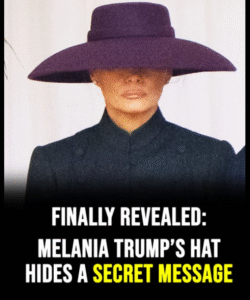Veiled Intentions: The Secret Message Beneath Melania Trump’s Hat
In the theater of diplomacy, every gesture is a line of dialogue. Every outfit, a paragraph. And every accessory—a whisper. When Melania Trump stepped onto the lawns of Windsor Castle beside President Donald Trump for their historic second state visit to the United Kingdom, she wore a wide-brimmed purple hat that seemed to speak louder than any speech delivered that day.
Observers were quick to notice. The hat, dramatic and regal, obscured much of her face. It cast a shadow across her eyes, creating a barrier between her and the world. Some called it mysterious. Others called it defiant. But beneath the brim, many sensed a message—one not embroidered in thread, but woven in symbolism.
According to stylist Marian Kwei, the hat was no accident. “The hat with the wide brim that hides her face is pointing to a stance where she wants all eyes on her husband and his agenda while here,” she told the BBC. It was the same shade of purple as Donald Trump’s tie—a visual echo, a nod to unity, or perhaps complicity. In a setting defined by royal protocol and centuries of tradition, Melania’s choice felt deliberate, even strategic.
Purple, after all, is the color of royalty. It has long signified dignity, power, and sovereignty. By choosing it, Melania was not merely dressing for the occasion—she was engaging in sartorial diplomacy. Vanessa Friedman of The New York Times noted that her Burberry trench coat, worn upon arrival, was a British-made gesture of goodwill. But the hat was something else entirely. It was a shield, a statement, and a cipher.
Lip readers later revealed that King Charles himself joked about the hat, telling Melania, “I do hope the wind doesn’t blow away your hat”. It was a moment of levity, but also acknowledgment. The hat had become a character in the unfolding drama—a silent protagonist in a story of presence and privacy.
Fashion experts like Oriona Robb believe Melania’s outfit choices are “rarely accidental.” “When she wears a large hat that partially hides her face, it can feel like a way to keep control, to shield her expressions and maintain a sense of privacy, even in public,” Robb told Metro UK. “It’s almost like saying, ‘you can look, but you don’t get everything.’”
This is not the first time Melania has used fashion to speak. In 2018, she famously wore a jacket emblazoned with the words “I really don’t care, do you?” during a visit to a children’s shelter in Texas. The backlash was swift, but the message was clear: Melania’s wardrobe is a language of its own.
During this state visit, she wore five outfits in 48 hours, each meticulously chosen. From a vintage Burberry trench to a canary yellow evening gown, her fashion thunderbolts were not just aesthetic—they were strategic. Her stylist, Herve Pierre, reportedly worked with military-like precision to craft each look. The usual rules of diplomatic dressing did not apply. Melania was writing her own playbook.
And the hat? It was the punctuation mark. A full stop. A veil of intention.
Some interpreted it as a retreat—a way to shield herself from scrutiny. Others saw it as a power move, a visual assertion that she was not merely a First Lady, but a sovereign figure in her own right. “She is sending a message that the ‘real’ royalty is her husband,” one social media user wrote.
But perhaps the message was more personal. Melania has often spoken of feeling bullied and misunderstood. “I’m the most bullied person in the world,” she once claimed. The hat, then, becomes a kind of armor—a way to be present without being exposed. A way to participate without surrendering.
In the context of Windsor Castle—a place steeped in history, hierarchy, and spectacle—the hat was a quiet rebellion. It did not bow. It did not curtsy. It did not conform. It simply existed, unapologetically.
And people noticed.
The viral photo of Melania with King Charles and Queen Camilla captured the moment perfectly. Her face half-hidden, her posture composed, her presence unmistakable. In a sea of red tunics and gold braid, she stood apart—not by volume, but by silence.
Fashion, at its best, is a form of storytelling. It reveals, conceals, and transforms. Melania Trump’s hat was not just a piece of clothing—it was a narrative device. It told a story of distance, dignity, and deliberate ambiguity. It invited interpretation, speculation, and projection.
In the end, the secret message beneath the hat may not be a single sentence, but a layered monologue. It speaks of legacy, of loyalty, of the tension between visibility and privacy. It speaks of a woman navigating the spotlight with calculated grace. It speaks of a state visit where the loudest statement was made not with words, but with a brim.
And as the carriages rolled through Windsor, and the military bands played their anthems, Melania Trump remained a figure apart. Not rebellious, not submissive—simply herself. In a moment of spectacle, she chose silence. In a palace of bows, she offered a shield. In a world of scrutiny, she wore a hat.
And people listened.


